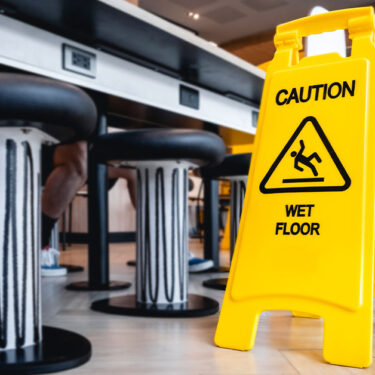A recent study examined 1.2 million on-the-job injury reports to determine which populations are most vulnerable to Workers’ Compensation Insurance claims, Property Casualty 360 reported this month. Brand-new hires were responsible for 34% of all claims assessed; among small businesses, first-year workers made up around 43% of claims, the publication reported.
Featured Solutions
The report also showed that employees at age 60 or older were injured on the job less often but had more expensive claims, costing 15% more than workers ages 35 to 49 and 140% more than employees ages 18 to 24.
“The older you get, the more expensive it usually is to treat a claim,” Dorman said, pointing to preexisting health conditions and other factors. “That is just the nature of the beast.”

There has always been a correlation between first-year workers and claims, and it appears that these claims are happening even more now than in the past.
The new data linking work experience and age with Workers’ Compensation Insurance claim frequency and severity also makes sense given labor shortages and other “unprecedented volatility” in the workforce during the COVID-19 pandemic, said Morgan McCoy, Underwriter, Workers’ Compensation, Burns & Wilcox, Charleston, South Carolina.
“This has definitely been a trend, and we did not see this happen as often before COVID-19,” McCoy said. “We 100% have seen the claims rise with first-year employees. The percentage of employees over age 65 is also something Workers’ Compensation carriers want to know about.”
Assessing risks with an evolving workforce
According to projections from the U.S. Bureau of Labor Statistics, about 25% of the workforce will consist of individuals aged 55 and above by 2024, Fortune reported in September of 2022. Of these workers, around one-third will be 65 years or older. In addition, data shows that while 58% of 65-year-olds in the U.S. were retired in the year 2000, today that figure is 45%, the Federal Reserve Bank of Minneapolis reported in February.
While some seniors are working beyond the traditional age of retirement, worker shortages remain a pressing issue for employers. Officials say around 3.5 million individuals are missing from the labor force compared to previous projections, due in part to early retirements, COVID-related deaths and disabilities, and other effects associated with the pandemic, the New York Times reported late last year. With many employers desperate for job candidates, rates of workplace injuries among first-year workers may continue to rise.
“It is hard to find employees still, so you may be hiring workers that are not necessarily the best qualified, but you still need boots on the ground,” Dorman said. “Then you may end up with employees whose hands need to be held a little bit more, and that definitely can cause more Workers’ Compensation claims.”
According to a 2022 survey from Prudential, 22% of workers switched jobs during the pandemic. Many sought out entirely new careers, Dorman pointed out, introducing a new wave of inexperienced workers who could be at greater risk for workplace injuries. “A lot of this really stems from COVID,” he said. “We have this shift of individuals kind of reevaluating what they are doing and shifting into different jobs and industries. We are still seeing that now.”
When workers are injured on the job, Workers’ Compensation Insurance can pay for the employee’s medical expenses, a portion of their salary while they recover, rehabilitation services, return-to-work programs, and more.

Workers’ Compensation Insurance is the very first policy that is going to be triggered when any type of injury claim happens. It is extremely important.
“Rehab is a very important part of Workers’ Compensation Insurance, especially for older employees,” Dorman explained. “It can also pay for retraining to put them into a different job if they cannot physically perform the job they were doing before. Vocational rehab is a piece of that coverage.”
McCoy added, “Workers’ Compensation Insurance is the very first policy that is going to be triggered when any type of injury claim happens,” noting that Commercial General Liability (CGL) Insurance and other policies could later be involved. “It is extremely important. If you do not have Workers’ Compensation Insurance and an employee wants to sue you, you are likely going to pay out big time.”
Costly claims possible in any work setting
The most common types of workplace injuries leading to Workers’ Compensation claims were strains and sprains, accounting for 38% of claims, while overexertion was the most common cause of injury, according to the study published in Property Casualty 360. Dislocations were the most expensive among the more common injuries, although “outliers” like amputations were among the most expensive claims evaluated.
Medical costs in the U.S. were up by about 2.3% in February compared to the previous year, which was a slower rate of inflation compared to other goods and services during the same time period, the Kaiser Family Foundation reported in March. However, some experts believe medical inflation will be pushed higher soon, the Los Angeles Times reported on March 29.
Employers should keep in mind that even lower-risk work settings and roles, such as office and clerical work, can bring the potential for serious Workers’ Compensation Insurance claims, Dorman said. “There was a claim a while back involving an older individual who just happened to fall out of their chair in their office. It led to a giant claim because of all the complications that arose from it,” he said. “That may not have happened with a younger employee.”
While any employee could face unexpected complications, older workers could be especially vulnerable to this type of incident. “We are definitely seeing that trend,” Dorman said.
Over the past several years, Workers’ Compensation Insurance rates have remained stable or declined, but a continual rise in claims or claim costs could start to reverse that, Dorman noted. While it is unclear whether the current trends could point to a “tipping point” ahead, the next few years will be important to watch. “I do not think carriers are going to increase rates right now, but we may have a better idea of the impact of these trends in two to three years,” he explained. “I think it will eventually be part of what leads to Workers’ Compensation Insurance rates leveling out. However, I do not think we will see it become a hard market because of how slow the industry moves. It is an industry that we can monitor closely and keep up with the trends.”
That has been the case with the issues involving today’s aging workforce and the increase in accidents among first-year employees, he added. “The trends we are seeing now are definitely ones that those of us in the Workers’ Compensation industry have been following,” Dorman said. “It is not something that happens overnight. It sounds like some of that is starting to show up in the data.”
The employer’s role in protecting workers
To help limit losses, Workers’ Compensation Insurance underwriters may have guidelines surrounding new companies. This could make a difference in rates or limit the carriers that will offer coverage to these new ventures, Dorman said. “Some carriers do not even write companies in their first year,” Dorman said. “That is the time when they are still learning, they are still hiring, and they are more prone to losses in that first year.”
Employers should also consider worker safety as it relates to assault and other threats, as workplace violence has been described by the Insurance Journal in 2021 as an “ever-growing concern” for U.S. employers. Earlier this month in California, a grocery store worker claimed he was fired after applying for Workers’ Compensation due to panic attacks after being assaulted three times at work, Fox Business reported. According to McCoy, Workers’ Compensation Insurance claims have also been filed over issues like bullying and harassment in the workplace.

If you are hiring someone for the first time, you want to make sure they are fully trained and comfortable in their surroundings. Do not put someone in a position where they are more likely to get injured.
“That is absolutely something I have seen,” McCoy said. “Employers should definitely be aware of it.”
Protecting employees is an employer’s responsibility, Dorman emphasized. This includes providing workers with appropriate training, resources and a safe environment in which to work.
“You want to make sure everything in your office is safe for employees of all ages — not just ergonomics but all aspects,” Dorman said. “Take into consideration all age ranges, no matter what you are doing.”

Whenever someone is hired, they should read and sign [a workplace safety policy]. That is a huge thing and insurance carriers really care about that.
This advice is also relevant for businesses taking on new hires who are not as familiar with the industry or role. “It has a lot to do with training and making sure that employees have all the tools they need instead of just throwing them into the deep end,” Dorman said. “If you are hiring someone for the first time, you want to make sure they are fully trained and comfortable in their surroundings. Do not put someone in a position where they are more likely to get injured.”
McCoy suggested that employers host frequent safety talks with their workers and always have a workplace safety policy in place. “Whenever someone is hired, they should read and sign that policy,” McCoy said. “That is a huge thing and insurance carriers really care about that.”







